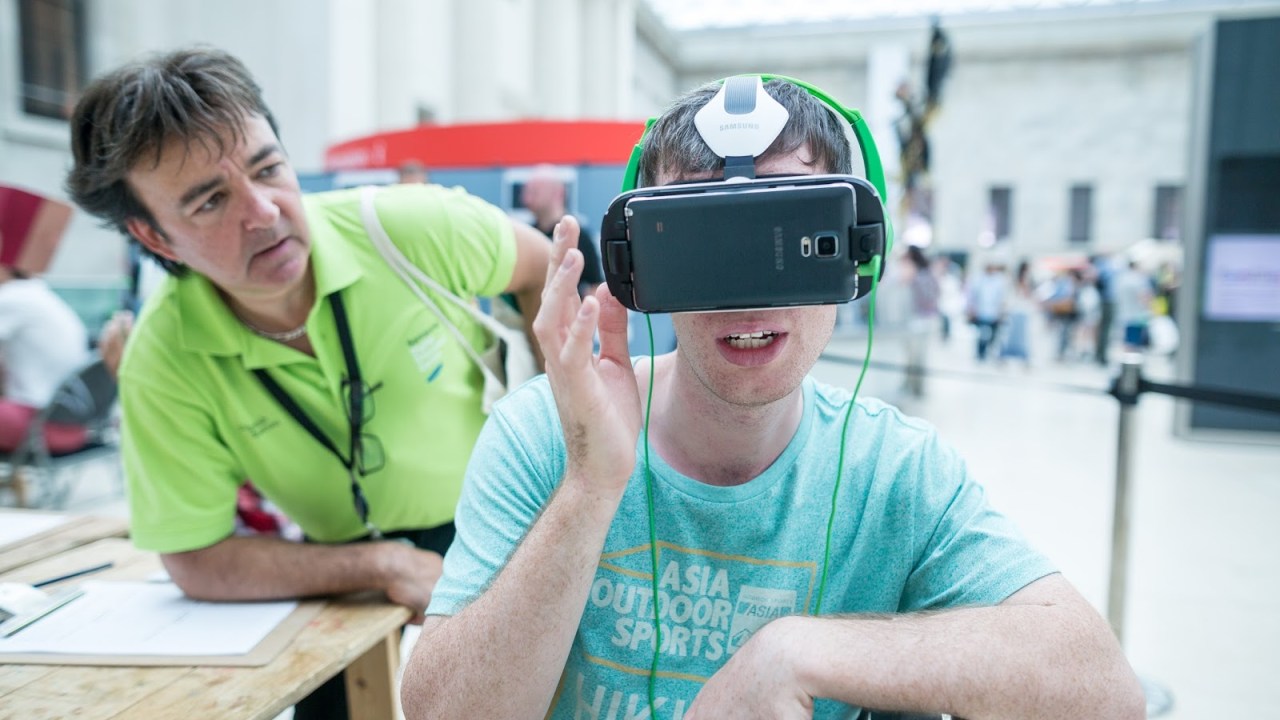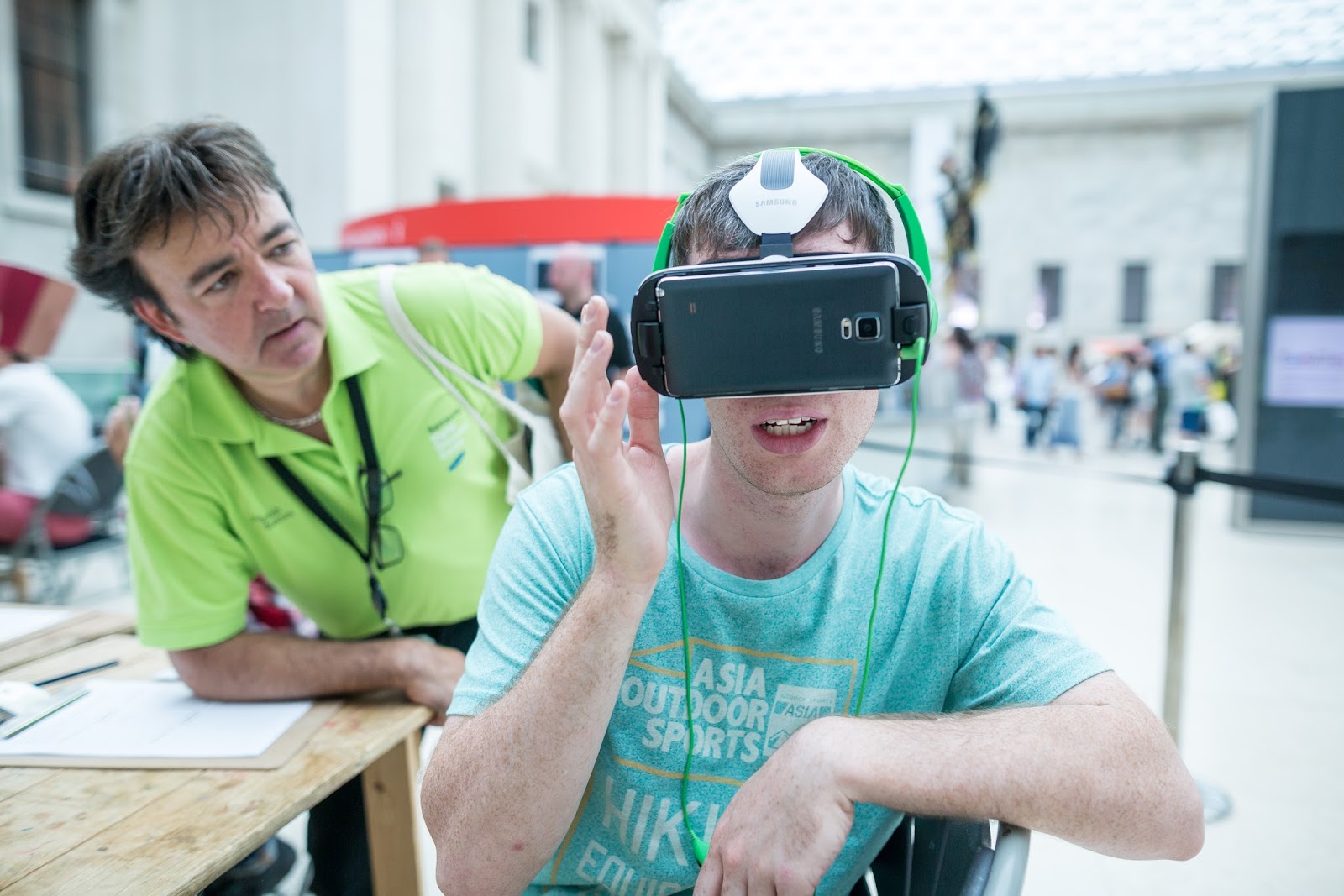
2016 is clearly a break-out year for Virtual Reality (VR) technologies, with numerous companies releasing relatively affordable, consumer-ready devices. Still, when I was writing TrendsWatch 2016 last fall, I found relatively few museums that had already adopted the newest entries into the VR market. The British Museum was one, and in today’s guest post Juno Rae and Lizzie Edwards, Education Managers of the British Museum’s Samsung Digital Learning Programme talk about their work with Samsung Gear VR, and share some tips for other museums planning to develop content for the virtual realm.
 In August 2015 the British Museum’s Samsung Digital Discovery Centre (SDDC) held a Virtual Reality Weekend in the Museum’s Great Court, offering over 1200 family visitors the opportunity to engage with Bronze Age objects from the collection in a virtual reality roundhouse settlement via Samsung Gear VR headsets, Samsung Galaxy tablets and an immersive dome.
In August 2015 the British Museum’s Samsung Digital Discovery Centre (SDDC) held a Virtual Reality Weekend in the Museum’s Great Court, offering over 1200 family visitors the opportunity to engage with Bronze Age objects from the collection in a virtual reality roundhouse settlement via Samsung Gear VR headsets, Samsung Galaxy tablets and an immersive dome. This post shares the tips and tricks from the project, which are useful for other organisations interested in developing similar experiences. Our paper for the Museum and the Web conference 2016 details the background of developing this VR experience.
For us, as people passionate about creating new access to and engaging audiences with museum objects, the Virtual Reality Weekend demonstrated that the virtual presentation of objects does not detract from or replace real life experiences of them. Rather, our virtual reality environment enhanced our audiences’ interest and excitement about Bronze Age objects.
After viewing the Bronze Age roundhouse on a tablet, Samsung Gear VR headset or in an immersive full-dome, visitors were excited to see more. For example, many gathered around another Sussex loop and ceremonial dirk in the Museum’s Bronze Age gallery, which are objects similar to the ones shown in the virtual Bronze Age roundhouse. During that period in August of 2015, the Wollaston Gold – also featured in the roundhouse – was also on display in the Museum while it was undergoing the Treasure process with the Portable Antiquities Scheme, and could be viewed complete with the soil it had been excavated with still present. We offered special tours of the Bronze Age gallery over the weekend that were enthusiastically taken up by visitors who would normally be more inclined to see the collection of Egyptian mummies.
Visitors valued the added context that the VR tour provided—further enhancing the real life experiences of these objects. They told us: “it made me feel as if I was actually there and gave me a sense of how things actually were in the Bronze Age.” Others shared, that it was a “Fantastic, interactive way to learn…it really helps visualize the height and depth of a Bronze Age village”. The VR experience allowed us to address popular misconceptions of this historic period, demonstrating for example that people lived in community groups and round houses.
Integrating virtual reality into the core Samsung Digital Discovery Centre programmes
Since the Virtual Reality weekend event in August 2015, we have continued to host various VR trials within the SDDC’s core programme through a series of new sessions for family members, teen visitors, and Continual Professional Development (CPD) workshops for teachers we launched the following:
- The SDDC’s ‘Teens 3D scanning skills workshop’ in November 2015 offered teen participants (ages 15-19) an opportunity to learn how:
- 3D scans are being utilised in museums
- Try out the Samsung Gear VR headsets
- Learn some basic 3D scanning skills
- Make their own 3D scans of museum collection objects using basic scanning applications via mobile phones.
In October 2015, we hosted a family session – ‘every drawing tells a story’ – inviting family visitors to develop their digital drawing skills using a range of creative software on tablets and phones. They used handling objects -including Bronze Age replica objects for inspiration. The Virtual Reality content helped families to explore their Bronze Age objects, learn more about their materials, and draw more objects. In December 2015, we hosted another family session – ‘Animate Celtic Craft’ – introducing visitors to the idea that the Celts were famous for creating complicated woven patterns and encouraged participants to work together to make an animation showing their complexity. Our Bronze Age roundhouse settlement experience via tablets and a Gear VR headset (for participants aged 13+ to use) provided visitors with background information on the lives of the Celts.
In January 2016, as part of a CPD event to provide support and ideas for UK Primary School teachers (ages 7-11 years) we facilitated a workshop to help school teachers incorporate digital tools into their prehistory curriculum. This session highlighted 3D scanned object repositories including Sketchfab and MicroPasts. The teachers also used the Gear VR headset as a tool to support students to visualise historical contexts.
Feedback from visitors on the inclusion of virtual reality into the Museum’s digital learning programmes has been extremely positive – we’re really excited to explore how best to continue to integrate the technology across the SDDC programme.
Tips for developing your own VR experience
We learned a lot from developing and delivering our virtual reality experience to our audience.
Our top tips for creating a VR experience are to:
- Put your audience first
- Collaborate with curators
- Make the most of available assets.
Putting our audience first drove our decision to present our VR world on three platforms (tablet, headset and dome), making it accessible to the widest range of visitors. It also drove our decision to create an open-ended user journey. Visitors explored the world at their own pace and followed their own interests. Neil Wilkin – curator of the Museum’s Bronze Age Collections– ensured that our historic context was as accurate as possible, and that it didn’t introduce new myths about how people in the Bronze Age lived. Finally, we used objects from the British Museum’s collections that had been scanned by the project, and provided as open source data, making use of pre-existing work and cutting down on development time
As an early adopter of VR headset technology, we also honed our methods of facilitating this experience for museum visitors. During the Virtual Reality Weekend we ran a model of 1-1 facilitation for the headsets, with five headsets available for visitors to use. Each facilitator found out the name of the visitor before they put the headset on. This proved important, as some attendees were so immersed in the experience that using their name was the only way to bring them from the Bronze Age back to the present day. One-to-one facilitation allowed us to be dynamic in our facilitation and able to accommodate the questions of visitors.
About the Samsung Digital Discovery Centre
The Samsung Digital Discovery Centre was created in 2009 to provide a state-of-the-art technological hub for children and young people to learn about and interact with the Museum’s collection. Offering the most ambitious and extensive on-site digital learning programme of any UK museum, the SDDC runs thirteen different school programmes throughout the school year, and has family programmes operating fifty two weekends a year. All activities are free and over 60,000 children and families have been welcomed to the Centre since it opened. Through its work with Samsung the British Museum remains at the forefront of digital learning. Recent innovations within this exciting partnership include the use of augmented reality and virtual reality technologies to engage a new generation with the British Museum’s Collections.









Congrats to the British Museum, great blog post and vision!
All museums really should be looking into new technology such as this. It's highly commendable that your blog has seen this experience as so valuable for museums and has produced several posts on it. When can we expect something about HoloLens?
I am a strong proponent of technological engagement. I would like to point out that in order to realize the full potential of interactive and metacognitive exhibits, it is crucial they not be considered an end unto themselves but rather be viewed as a valuable link in the experiential chain connecting academic study and personal growth.
A prime example of this would be the Neurodiverse City project designed to improve social outcomes for the disabled by promoting empathy for the people behind the labels. http://tinyurl.com/gw3bsre
We've seen a virtual reality explosion and in 2017 there's now an amazing variety of VR Headsets to choose from.But which is the best VR headset out there? Well, for our money it's the brilliant HTC Vive, for its use of room-scale tracking to offer gamers and users the freedom to walk around and interact in the virtual world like never before But there are other options. The winner of the December sales shoot-out was the
Sony PlayStation VR Headsets, which sold nearly a million headsets thanks to its significantly lower price, not to mention the ubiquity of PlayStations ready to run Sony's headset.